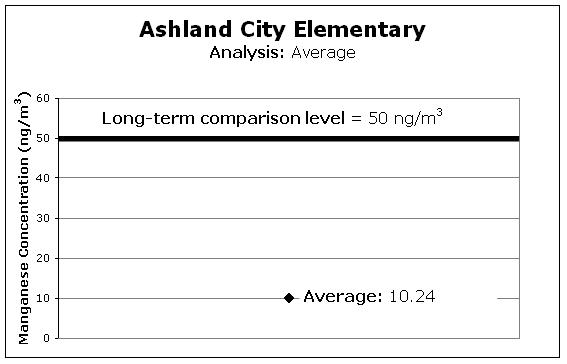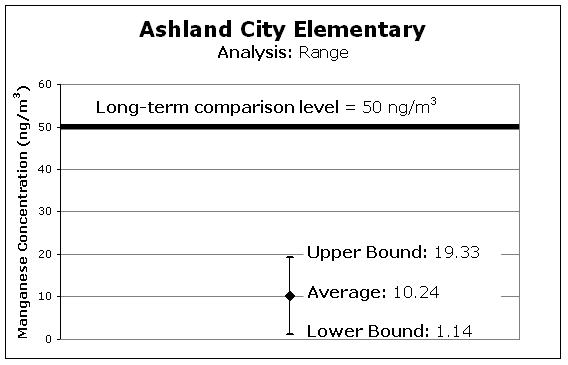Assessing Outdoor Air Near Schools
Ashland City Elementary School - Ashland City, TN
Results and Analysis of EPA’s monitoring
EPA selected this school for monitoring because it is located near at least one large industrial facility that is a source of air toxics emissions. Computer models were used to determine which air toxics may be present at elevated levels in the outdoor air near the school. These models showed that manganese could be present and prompted EPA to test to see if the levels present may be of concern.
| Primary Findings | Levels of manganese in the air at the school are below levels of concern for short-term and long-term exposure. |
| Key Pollutants Monitored | Manganese, which may affect the nervous system if people are exposed to high levels |
| Next Steps | EPA has decided to stop air toxics monitoring at Ashland City Elementary School at this time because levels of manganese in the air at the school are below levels of concern for long-term exposure to air toxics. The Tennessee Department of Environment and Conservation (TDEC) continues to oversee facilities in this area through several types of permits and voluntary programs. One of these permits, required by the Clean Air Act, outlines the legal emission control requirements industrial facilities must meet and must be renewed every five years, with opportunity for public comment. |
| Additional Activities | TDEC will collect more information on wind speed and direction at the school to better characterize long-term wind patterns. |
Summary of Study Approach and Findings
- A monitor collected air samples over two months at the Ashland City Elementary School in Ashland City, TN. Manganese was the key pollutant of interest.
- We provided individual air sample results throughout the monitoring period to keep your community informed during the monitoring period.
- Based on the monitoring results, we found no concern for risk of health problems from short-term exposures to manganese.
- When the monitoring was complete, we evaluated all the air samples from the on-site monitor. We also evaluated information on wind speed and wind direction from a weather monitor at the school, along with historical weather information and information about a nearby source of manganese emissions.
- Our analysis found that levels of manganese in the air at the school are below levels of concern for long-term exposure.
- Monitoring data also show other toxic air pollutants were present at very low levels in the air at the school. The analysis does not indicate that the combination of monitored pollutants poses a health concern.
- The analysis indicates that manganese concentrations in the air near the school are influenced by a nearby industrial facility.
- The concentrations of manganese measured at the school are lower than those suggested by the information that helped identify this school for monitoring.
- The process to identify schools for monitoring relied on emissions estimates and other information. Putting a monitor at the school allowed measurement of what was actually in the air.
- The most recently available manganese emissions estimates for the nearby facility from EPA’s Toxics Release Inventory for 2007 are lower than the estimates used to identify this school for monitoring.
- Because the analysis shows manganese levels are below levels of concern, EPA has stopped air toxics monitoring at Ashland City Elementary School.
- Click here for additional information
How We Analyzed the Information We Collected at this School
The analysis considered whether the information collected at the school might raise concerns for the health of children or adults at the school. We looked at the following types of information:
- Measured manganese concentrations, and information on manganese
- Measured wind direction and wind speed at the school
- Information about a nearby source of manganese emissions
Analysis of Measured Manganese Concentrations:
1. Calculate the average: We calculated the average of the manganese measurements (shown by the blue diamond in the graph below). We compared this average to the long-term comparison level (thick line on the graph below). The long-term comparison level represents the level of manganese in the air that is below levels associated with health concerns, even if someone breathed air containing manganese at that level all day, every day over their lifetime.
Result: The average manganese level for the samples collected was not above the long-term comparison level. The health concern is low.

2. Calculate a range: To account for varying air concentrations of manganese, we calculated a range around the average. We did this by estimating high and low values that the longer-term concentrations might reach using common statistical tools. We compared the highest point in the range (called the “upper bound”) to the long-term comparison level.
Result: The high end of the range is lower than the comparison level. The health concern is low.

Analysis of Measured Wind Direction and Wind Speed at the School
We took measurements of wind direction and speed every day during the sample period. We took special note of the wind speed and direction on the days we took measurements of manganese.
| What we looked at | What we found |
| We looked at whether the wind data taken on the days we took measurements of manganese are similar or different from the wind patterns during the entire monitoring period. | We found the wind patterns taken on the days we took measurements of manganese to be generally similar to those observed during the entire monitoring period. |
| We looked at whether the wind pattern during the monitoring period is similar or different from wind patterns over the long term. | We do not have a full year of wind data at this school. However, based on wind data in the general region, we concluded that wind patterns over the two-month sampling period were generally similar to the long-term patterns for the region. We are continuing to collect wind data at this school to better characterize long-term wind patterns. |
Analysis of Information on Nearby Source of Manganese Emissions
| What we looked at | What we found |
| Whether we could determine if the source was operating as usual during the monitoring period | This facility was operating at approximately two-thirds of its capacity during the monitoring period. This facility typically operates at 80 percent of its capacity. |
| The concentrations of manganese measured at the school are lower than those suggested by the information that helped identify this school for monitoring. | |
| The nearby source of manganese has an operating permit issued by the State of Tennessee that includes operating requirements. |
Additional Information
Technical Report for School: Assessing Outdoor Air Near Schools: Ashland City Elementary School (Ashland City, Tennessee) (PDF) (24pp, 242k). The technical report is geared toward risk assessors, risk managers, and other regulatory agencies.
Background on School Monitoring Effort
General Questions and Answers for School Monitoring Effort
